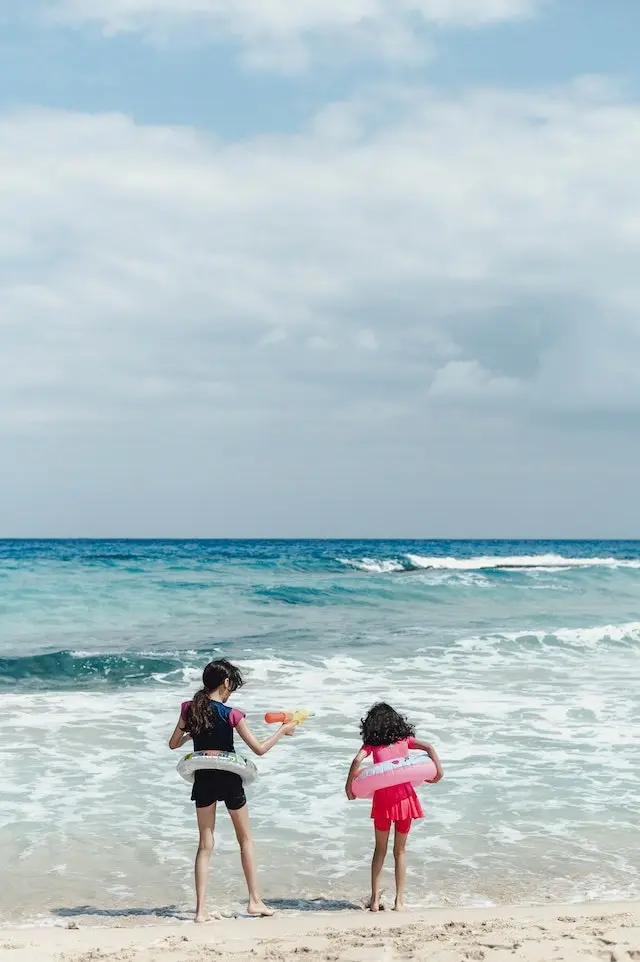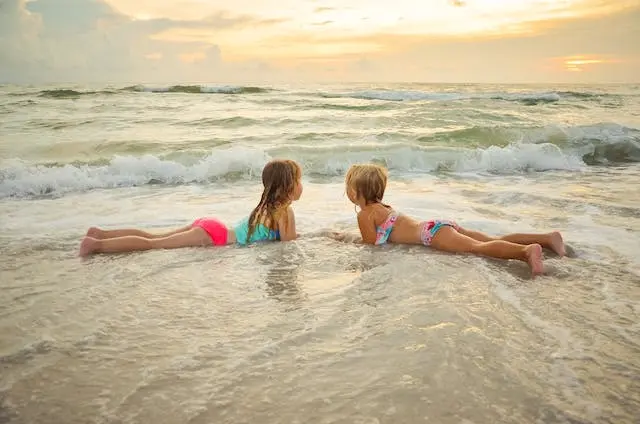A Comprehensive Guide: Essential Beach Safety Tips for Babies
Heading to the beach with your little bundle of joy? Ensuring beach safety for babies is paramount for an enjoyable and worry-free outing. In this comprehensive guide, we’ll explore essential tips to make your beach day with your baby a breeze.
Table of Contents
Why is beach safety crucial for babies?
- Babies Delicate Nature:
- Skin Sensitivity: A baby’s skin is thinner and more delicate than adults, lacking the melanin protection necessary to fend off the sun’s harsh UV rays effectively.
- Immature Immune System: Their immune systems are still developing, making them more susceptible to environmental elements.
- Sun, Water, and Sand Risks:
- Sun Exposure Risks: Extended exposure to the sun can lead to sunburn, heat rash, and potentially long-term skin damage.
- Water and Sand Issues: Prolonged contact with water can lead to skin dryness, and sand, while fun, can cause irritation or be ingested.
How Can I Protect My Baby’s Skin from the Sun?

- Clothing Choices:
- Material Matters: Choose lightweight, breathable fabrics that cover arms and legs.
- Wide-Brimmed Hats: Opt for hats with wide brims to shade the face, neck, and ears effectively.
- Sunscreen Application:
- SPF Considerations: Select sunscreen with broad-spectrum protection and a minimum SPF of 30.
- Application Techniques: Ensure thorough coverage, especially on commonly missed areas like the tops of feet and back of hands
What Beach Items Should I Pack for My Baby?
- Clothing and sun protection:
- Variety of Outfits: Pack a variety of clothing options to adapt to changing weather conditions.
- Sunshades and Tents: Portable tents or sunshades can provide additional protection during breaks.
- Diapers and wipes:
- Diaper Changing Essentials: Bring enough diapers, wipes, and changing pads for the day.
- Diaper Cream: Include a gentle diaper cream to combat potential irritation from wet diapers.
- Shade and comfort:
- Portable Shade Solutions: Consider collapsible, baby-friendly shades or umbrellas.
- Comfort Items: Bring comforting items from home, like a favourite blanket or stuffed toy.
How Can I Keep My Baby Hydrated at the Beach?

- Water and Formula:
- Sufficient Water Supply: Bring more water than you think you’ll need, accounting for both drinking and cleaning purposes.
- Formula Preparation: If using formula, bring pre-measured portions and sterilized bottles.
- Breastfeeding:
- Frequent Nursing: Breastfeed frequently to ensure your baby remains hydrated and nourished.
- Privacy Measures: Bring a lightweight nursing cover for privacy during breastfeeding sessions.
- Avoid sugary drinks:
- Dehydration Concerns: Sugary drinks can contribute to dehydration; stick to water or diluted fruit juices if necessary.
What Precautions Should I Take in the Water with My Baby?
- Gradual Introduction:
- Building Comfort: Begin with shallow waters, allowing your baby to acclimate to the sensation gradually.
- Playful Introduction: Incorporate play and toys to associate water with positive experiences.
- Supervision and Flotation Devices:
- Constant Vigilance: Never leave your baby unattended in or near the water, even for a moment.
- Age-Appropriate Floats: Utilize floatation devices designed for babies under close supervision.
- Shallow Waters:
- Safe Play Zone: Opt for areas where the water is consistently shallow, reducing risks associated with sudden depth changes.
- Wave Awareness: Be mindful of gentle waves and avoid areas with strong currents.
How Can I Protect My Baby’s Eyes from the Sun?

- Baby Sunglasses:
- UV Protection: Ensure sunglasses provide UVA and UVB protection.
- Comfort Fit: Opt for frames that comfortably sit on your baby’s face without being too tight.
- Proper Fit:
- Secured Straps: Choose sunglasses with adjustable straps to keep them securely on your baby’s head.
- Frequent Checks: Regularly check and readjust the fit to prevent discomfort.
What Snacks Are Suitable for My Baby at the Beach?
- Hydrating Snacks:
- Water-Rich Fruits: Offer hydrating fruits like watermelon, cucumber, and oranges.
- Ice Pops: Prepare natural fruit juice popsicles for a refreshing treat.
- Finger Foods:
- Easy-to-Eat Choices: Opt for small, bite-sized snacks to minimize choking risks.
- Healthy Choices: Include cheese cubes, whole grain crackers, and sliced veggies.
- Cooler for Perishables:
- Temperature Control: Use a cooler to keep perishable items at a safe temperature.
- Packaging Considerations: Use reusable ice packs to maintain freshness.
How Can I Create a Safe Play Area for My Baby on the Beach?

- Designated Play Space:
- Clearly Defined Area: Use a beach blanket or baby-friendly playpen to create a clear play zone.
- Visual Boundaries: Mark the play area with bright toys or flags for visual recognition.
- Blanket or Playpen:
- Comfort and safety: Lay a soft, comfortable blanket to create a cosy spot.
- Shaded Space: Position the blanket or playpen in a shaded area to avoid direct sunlight.
- Check for hazards:
- Debris and Sharp Objects: Thoroughly scan the area for debris, shells, or sharp objects that could harm your baby.
- Secure Items: Anchor lightweight items to prevent them from blowing into the play area.
How Do I Protect My Baby from Sand-related Issues?
- Covered Sensitive Areas:
- Diaper Area Protection: Apply a barrier cream to the diaper area to prevent sand from causing irritation.
- Loose Clothing: Dress your baby in loose-fitting clothing to minimize sand contact.
- Use of Baby Powder:
- Sand Removal Aid: Dusting baby powder helps absorb moisture, making it easier to brush off sand.
- After-Play Routine: Apply powder after playtime to facilitate easier cleanup.
- Rinse before meals:
- Hand and Face Rinse: Use a gentle spray bottle or wipes to rinse your baby’s hands and face before meals.
- Preventing Sand Ingestion: Minimize the risk of accidental sand ingestion during meals.
What Should I Do If My Baby Shows Discomfort at the Beach?
- Move to Shade:
- Immediate Relocation: If your baby shows signs of discomfort, move to a shaded area promptly.
- Cool Down: Use a damp cloth or cooling pad to alleviate discomfort from heat.
- Check for overheating or sunburn:
- Assessing Overheating: Feel your baby’s neck and back for excessive warmth, indicating overheating.
- Sunburn Assessment: Check for redness or warmth on exposed skin; apply aloe vera for sunburn relief.
- Seek medical attention if needed:
- Persistent Discomfort: If your baby continues to exhibit signs of distress, seek medical attention.
- Allergic Reactions: Be vigilant for signs of allergic reactions and seek immediate medical help if observed.
Conclusion
By meticulously addressing each element of beach safety, you’re ensuring not only a secure but also an enriching experience for your baby. Following these comprehensive precautions will contribute to a day filled with joy and exploration, allowing your little one to create beautiful beach memories in a safe environment.

Why is sun protection crucial for my baby at the beach?

Babies have delicate and sensitive skin that is highly susceptible to sunburn and long-term damage from UV rays. Providing adequate sun protection, including sunscreen, protective clothing, and shade, is essential to safeguard their skin and overall health during beach outings.
What precautions should I take for my baby during water activities at the beach?

Water safety is paramount for babies. Dress your baby in a well-fitting swim diaper, use baby-friendly sunscreen, and ensure constant supervision. Avoid strong currents, and if you’re bringing inflatable water gear, make sure it is suitable for infants and properly inflated.




